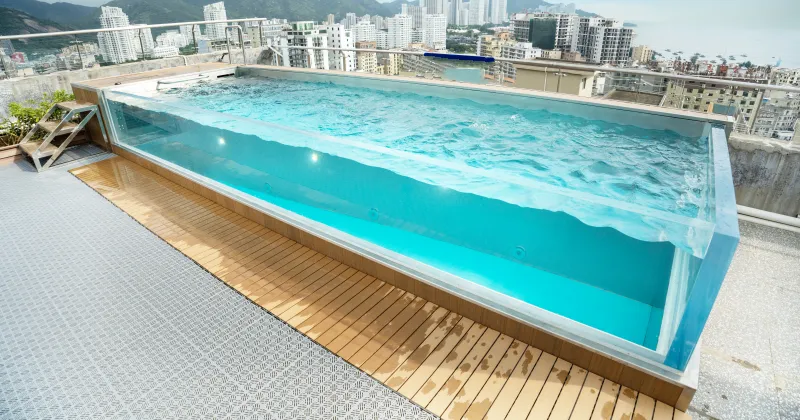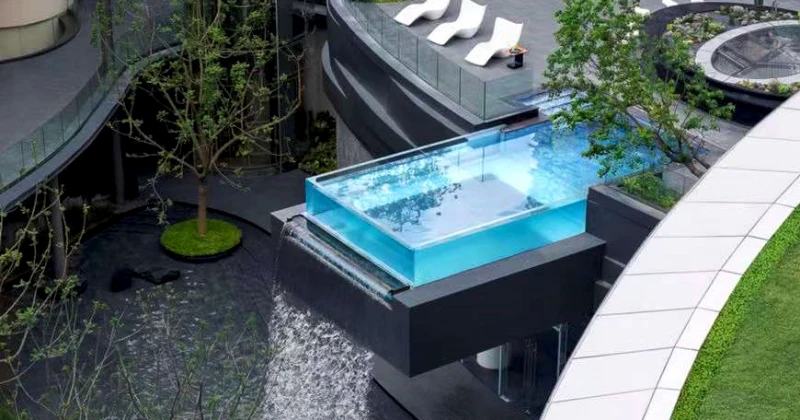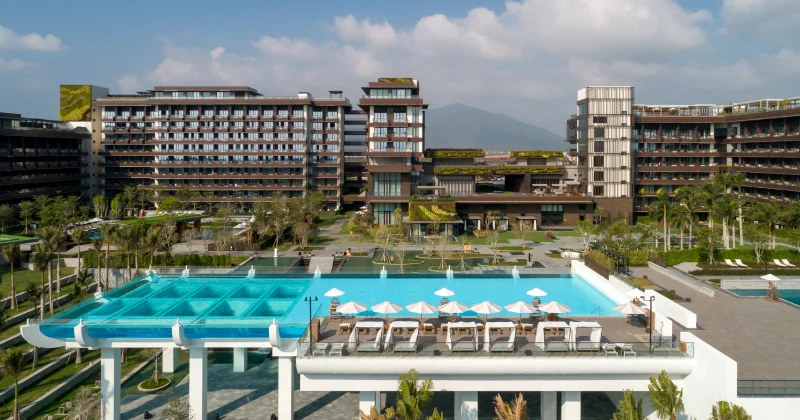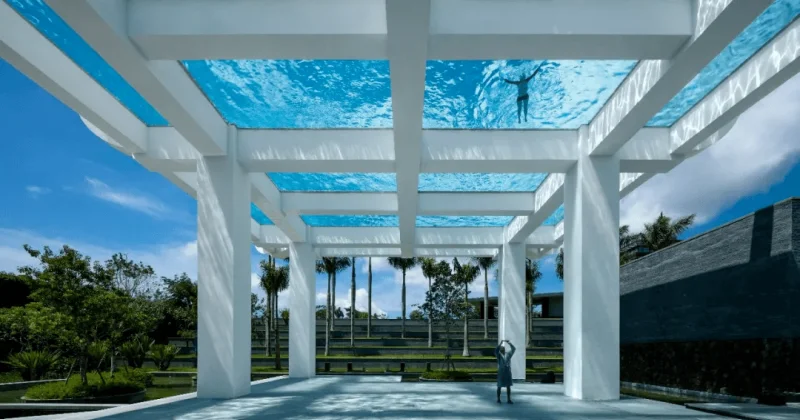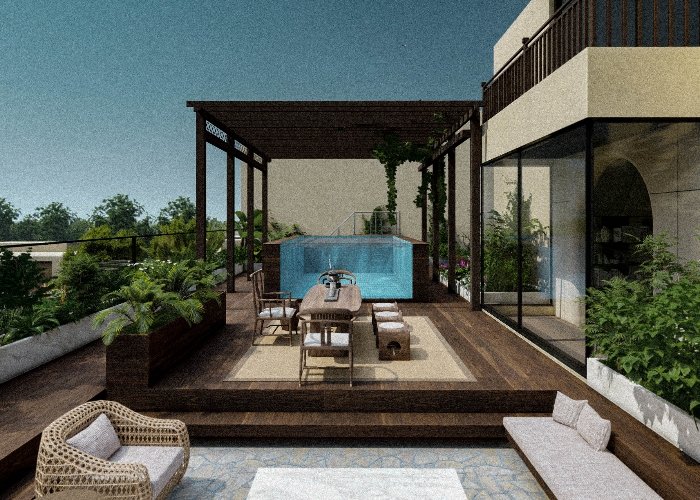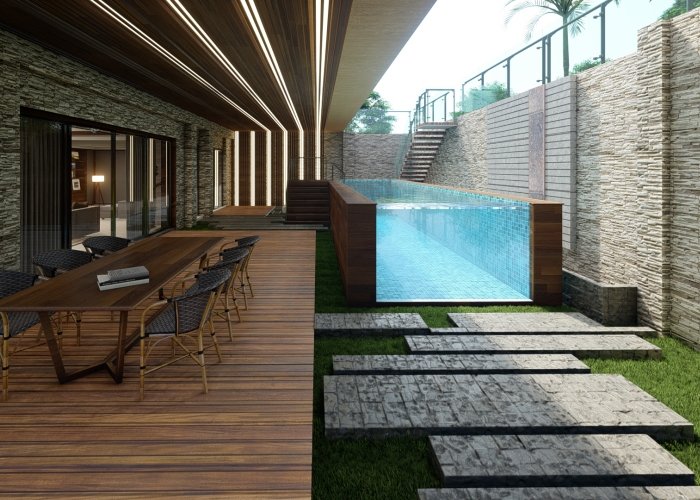
Understanding Different Types of Transparent Pools
The emergence of transparent pools has transformed the traditional application and concept of swimming pools. They are no longer merely vessels for swimming but have become a means of enjoying a relaxing and comfortable atmosphere or a focal point designed to capture attention. Swimming pools have evolved from simple backyard amenities into stunning architectural marvels that we can see in luxury hotels, private villas, or on social media. Various types of transparent pools add unique visual appeal and excitement. In this article, we will delve into different types of transparent pools, including transparent pools, glass-bottom pools, glass-walled pools, pool windows, acrylic pools, plexiglass pools, and see-through pools.
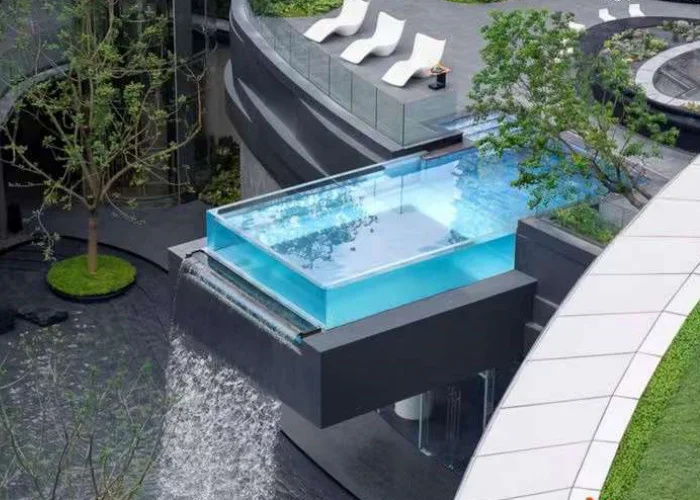
1.What is a transparent pool?
A transparent pool refers to a swimming pool where transparent materials, such as glass, acrylic, or plexiglass, are used in place of some traditional materials during construction. These materials allow light to pass through, creating a striking visual effect. The design of transparent pools can vary widely, from fully transparent sides and bottoms to specific transparent sections, offering unique perspectives and aesthetic appeal. Transparent pools not only enhance the visual attraction of a pool but can also seamlessly integrate with the surrounding environment in certain designs. For instance, transparent pools are commonly used in luxury homes, hotels, and resorts, providing a unique experience for residents and guests.
The structural design and material selection for transparent pools require special attention to safety and durability to ensure reliability over long-term use.
For more information on transparent pool materials, visit: Type of Pool Glass.
For engineering case studies of transparent pools, visit: Transparent Pool Case.
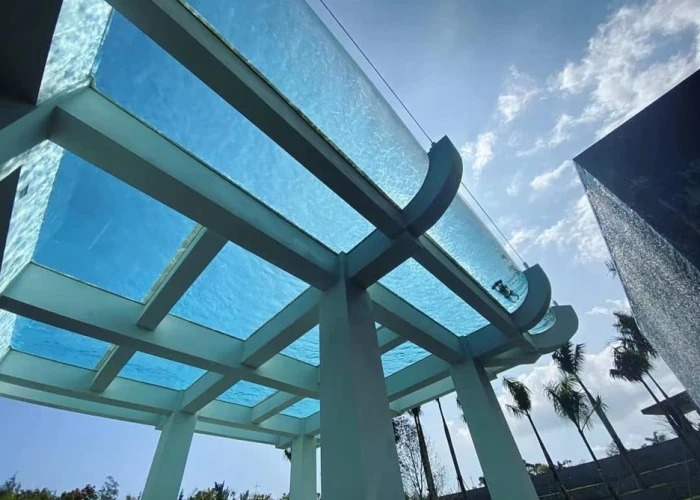
2.What is a glass bottom pool?
A glass-bottom pool replaces the traditional materials of the pool's bottom with transparent materials, making it appear as if the pool has no bottom. This creates an awe-inspiring experience for both swimmers who can look down and see the ground or other landscapes, and for viewers who can look up and see the swimmers inside the pool. Glass-bottom pools are typically built in high places, such as suspended at the top of buildings or located at the edge of cliffs, providing stunning views and a thrilling swimming experience. These pools are commonly found in high-rise hotels and luxury resorts, combining natural beauty or urban landscapes with the swimming experience to offer guests a unique sensory delight.
For safety, the materials used for glass-bottom pools are usually not actual glass but high-safety acrylic materials that can withstand the dynamic pressure from water and swimmers without breaking.
For more information on materials for glass-bottom pools, visit: Is an Acrylic Pool Safe?
For engineering case studies of glass-bottom pools, visit: Glass Wall Pool Case

3.What Is a Glass Walled Swimming Pool?
A glass wall swimming pool uses transparent materials, typically acrylic or glass, for the pool walls. This design creates a stunning visual effect, allowing people inside and outside the pool to see each other. Glass wall pools are commonly used in modern architectural designs, such as rooftop pools, high-end residences, or commercial buildings, offering a sense of openness and connection. Through the transparent walls, swimmers can enjoy the surrounding scenery while those outside can observe the activities within the pool. This design not only enhances the visual appeal of the space but also provides a luxurious and modern ambiance. Glass wall swimming pools represent an innovative direction in modern pool design, combining advanced architectural techniques with unique aesthetic experiences, offering users a new way to swim and relax.
For information on how to install glass walls and more details: Acrylic Glass Walled Pool
For engineering case studies of glass wall swimming pools: Glass Wall Swimming Pool Case Study

4. What is a pool window?
A pool window refers to a portion of the pool wall that is transparent, rather than replacing the entire wall with transparent materials like in a glass wall pool. Pool windows provide a unique perspective where both inside and outside views of the pool are visible, enhancing the visual appeal of the pool. These windows can be designed in various shapes and sizes, ranging from large panoramic windows to small, delicate viewing panels. Pool windows are commonly used in indoor pools, aquariums, and public swimming facilities, creating pleasant visual effects and enhancing the swimming experience. Through pool windows, swimmers can observe the external environment while spectators outside can enjoy activities within the water. This design not only increases the pool's attractiveness but also provides an opportunity for interaction and engagement.
These windows are typically made from durable and sturdy acrylic materials rather than glass. The reasons for this choice are explained here: Glass or Acrylic Panels for Pool Windows

5. What is an acrylic pool?
An acrylic pool refers to a swimming pool that is fully or partially constructed using acrylic, a transparent plastic renowned for its strength and clarity. Acrylic pools are highly durable and resistant to various natural elements, suitable for both indoor and outdoor use. The transparency and seamless appearance of acrylic give it a modern and stylish look, making it a popular choice for high-end residential and commercial projects. Acrylic pools can be designed in various shapes and sizes, offering limitless creative possibilities. Due to the material properties of acrylic, these pools not only look attractive but also offer excellent durability and safety.
In the design and construction of acrylic pools, considerations include the thickness of the material and its structural integrity to withstand water pressure and external environmental factors. Determining the appropriate thickness of acrylic material is crucial, balancing cost-effectiveness with safety considerations.
For guidance on determining the suitable acrylic thickness, visit: How to Determine Acrylic Panel Thickness

6. What is a plexiglass swimming pools?
People often use the terms plexiglass and acrylic interchangeably. In fact, there is no difference between them. Acrylic is short for polymethyl methacrylate, and Plexiglas is one of the many brand names for this type of plastic. Over time, the term "plexiglass" has become a generic name for acrylic. Therefore, when people talk about an organic glass swimming pool, they are essentially referring to an acrylic swimming pool, with no distinction between the two.

7. What is a see through pool?
Like acrylic pools and plexiglass pools, transparent pools and see-through pools refer to the same type of pool constructed using transparent materials such as glass, acrylic, or plexiglass, allowing the pool structure to be visibly transparent. Therefore, these pools do not have a distinct name; you can refer to them as see-through pools, transparent pools, acrylic pools, glass wall pools, and so on, and people will generally understand what you mean.

Conclusion:
Transparent pools represent a fascinating innovation in modern pool design, offering unique aesthetics and enhancing the swimming experience. Whether it's the thrill of a glass-bottom pool, the elegance of a glass wall pool, or the versatility of an acrylic pool, these see-through pools are changing the way we perceive and enjoy swimming. By understanding the different types of transparent pools, you can better appreciate the artistry and engineering behind these stunning aquatic designs.








